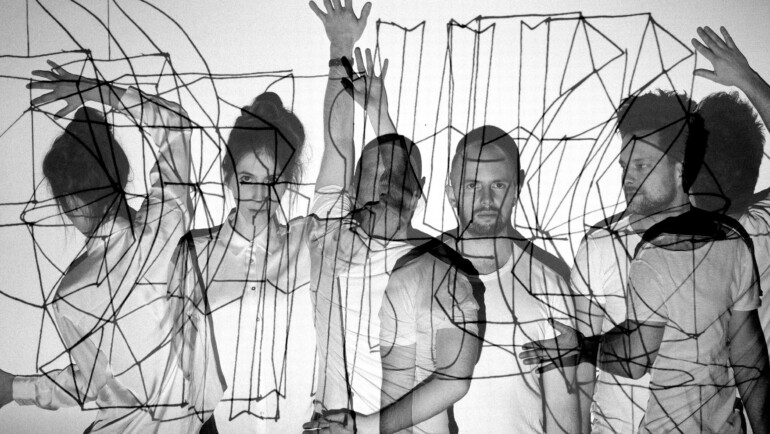
The goal of the trio otherMother is a rhythmic symbiosis of sound; their path to that goal is the fusion of acoustic and electronic sounds. Markus Deisenberger talks with Judith Schwarz, Jul Dillier and Arthur Fussy about the birth of the band, the relationship between rhythm and melody, and understanding magic.
Your instrumentation – extended drum set, prepared piano, and modular synthesizer – is unconventional. How did the three of you get together?
Arther Fussy: It was a COVID experiment. I live with Judith, and at the beginning of the lockdown we decided to try doing something together, with me on synthesizer and her playing the drum set she had moved into the apartment – so we started jamming and working on rhythmic structures. I had never played the synthesizer with live musicians before; it was completely new to me. We played for three or four hours a day for three or four months. It was really a great exercise for me to get into something like that, to see how to jam with a modular synthesizer. We knew pretty quickly that we wanted to make a project out of it, and it was also clear that we wanted a third member. I was making mostly rhythmic structures on the synthesizer, and Judith was as well, of course – it was obvious that the third person should be able to do that as well, and we quickly settled on Jul: he uses the piano in a very noise-oriented manner, like a rhythmic instrument. Almost no one else has perfected that approach to playing in the way he has in recent years.
“We play different instruments with the same vision”
Did you always know that no single instrument should be responsible for the beat – that all three instruments should be equal, playing overlapping rhythm and melody?
Judith Schwarz: Arthur and I were already acquainted from playing theater projects together, and we had thought about doing something together. Then I was in Saalfelden and I heard a jam session with four drummers, where they were communicating melodically with one another. The sound really grabbed me, and I thought a project like that would really be something. Not necessarily with three drummers, but percussive instruments that could still create melody – after all, rhythmic patterns are melodic as well. In the train on the way back to Vienna, I decided to start something like that – and then COVID started, and suddenly we all had more time to think, and I realized: the drummer on the piano is Jul.
Jul Dillier: The term “rhythmic symbiosis” in the bio describes what we’re searching for pretty well: a music based on sound-oriented rhythmic structures. And the idea of symbiosis – we’re not dividing up the responsibilities; we’re becoming a single entity that sounds like a big rhythmic complex, but it’s richer than a simple percussion ensemble. We play different instruments, but with the same vision.
So it’s about amalgamation?
Jul Dillier: The drums were my first instrument; I had three years of drum lessons before I started playing piano, and then I had at least ten years of both. Also, I’m from Switzerland, and I’m really influenced by the strong tradition of great Swiss drummers and rhythmists; that was always an inspiration to me and it influenced my piano playing. It’s normal to work with nuances of sound on the drums – you use different sticks, or switch a figure to the cymbals so that it sustains for longer. Piano always has just this one sound…
I know what you mean – a guitarist might have fourteen effects hooked up to his instrument, but people expect a specific, consistent sound from a saxophone, because they associate it with that one sound.
Jul Dillier: At least with the saxophone you can alter the sound using your mouth – the construction of the piano makes it much more abstract, and I quickly noticed that it wasn’t enough for me. I started using sticks, playing inside the piano, damping the strings with my hands to get other sounds. I’ve amassed a small arsenal of sound tools that I use to get different effects: for instance, I use magnets to create bell-like sounds, and I’ve borrowed tools from other instruments – like violin bows, with which I can create long tones like a stringed instrument. I get ideas from the way other pianists and instrumentalists play their instruments, and I think about how I could incorporate that in my playing.
Judith, what do you mean by “extended drums”?
Judith Schwarz: I prepare the drum set [acoustically], and I also have little tools to go along with it. I wouldn’t say percussion – I can’t play bongos or congas. I have a metal drum and other objects that I’ve found.
How easy or difficult is it to improvise with a modular synthesizer?
Arthur Fussy: The good thing about a modular synthesizer is that – because it’s modular – there are thousands of producers for the modules, so you can gradually build your dream instrument and tweak it for what you want you want it to be, what you want it to do. When we started, it looked completely different – it’s constantly changing; it’s like a tool box that keeps getting bigger, that I’m trying to perfect.
“almost nothing is composed”
How hard is that to do live? You have to drag all the modules with you to every gig, right?
Arthur Fussy: You have to have the patch cables really well organized. There are a whole lot of pre-patched cables that hold the whole thing together. So yes, it’s hard.
Judith Schwarz: Arthur’s got it under control – but the good thing is, something unexpected can still always happen and surprise us all; then we have to react to it in the free improvisation. The feeling of “being in the moment” is really important for free playing.
How much of the music on the album is composed; how much is improvised?
Arthur Fussy: Essentially, almost nothing is composed. We work with building blocks of sound that we categorize according to timbre, or that we give certain attributes. There are no predefined compositions; it’s all freely improvised.
A few days ago I interviewed the Vienna band Radian, and they described the – extremely complex – process of making their new album: a mixture of playing, processing, remixing, and overdubbing. How does it work with you?
Judith Schwarz: The album was created in the course of three concerts – we played three concerts in the summer that were all recorded. We did think about going into the studio, but we got to know each other so well during rehearsals that we worked out various codes with and for one another so we didn’t have to think while we were playing, and so we decided not to. Free improvisation is just our thing, and the album is a best-of from those three concerts.
Jul Dillier: We did recombine the live recordings, though, so it was still a pretty complex process: we looked for the most interesting moments, the ones that represented our playing best, and then we made those moments into an album – it has to have a shape, and it should feel like a live concert.
Analyzing the magic
And when you play live, you don’t reference the album; you do something completely different?
Jul Dillier: Right. Totally new and completely improvised. No themes that we play in another form. What we have developed, though, is a unique tonal language that we use in our improvisations. When you’re improvising, often these magic moments haben, but you don’t really know why they were so magical, so good. That’s why some improvising ensembles don’t rehearse that often, so that the concept stays fresh and something new can happen every time. We chose another way: during the pandemic, we took a lot of time to play long, improvised sets, then we listened to ourselves, analyzed, and tried to pinpoint the magic moments – we made an effort to define the moments that make [our music] interesting and to see how we could use them as modules and develop them further. Attempting to demystify the things we called ‘magic’ a little bit by practicing the structures – without writing them down – was a fascinating process for me.
So, the precise analysis allows you to repeat the magic.
Jul Dillier: Exactly – to pull it up and hone it further.
“Weird, that sounds like me”
Is intelligibility a factor? Or, to put it another way: is it important to you to make your music more understandable by incorporating a consistent pattern?
Judith Schwarz: That’s something we just feel. When we feel like there hasn’t been a beat for a while and it’s time for something concrete again, then we do it. Nothing is forbidden. We play the way we feel in the moment – and up till now I have the feeling that when it worked for us, it worked for the room.
Arthur Fussy: The way a synthesizer works, there’s always a clock running – there’s always a loop, a rhythm. Because of that, I’m often the person in the band who defines the meter – because I’m the only one who has a harder time adjusting to someone else’s tempo. But we’ve also worked on that and found ways that Judith or Jul can initiate the rhythm and I can join in.
A lot of times, we don’t even know which one of us is creating a specific sound. I hear something and think: weird, that sounds like me, but it wasn’t me at all – and then I realize it was Jul. We imitate one another often when we’re playing, it just happens automatically on the way to symbiosis. A lot of journalists write that you often don’t know who’s creating which sound; I find that interesting.
Jul Dillier: Sound engineers often have a hard time mixing us because they don’t know who’s doing the thing that they want to turn down. But one more thing about intelligibility: I don’t think it was ever our idea to play easily digestible free jazz, so we put a beat underneath it. But we do all play rhythmic instruments and we’re influenced by club music, although we don’t come from that background. Our concept was: we all come from experimental music, but there’s no reason it shouldn’t be danceable. At the same time, it was never our goal to be so abstract and intellectual that no one’s allowed to move to it.

Dive into the soup
How did you actually arrive at the name ‘otherMother’?
Jul Dillier: Arthur’s instrument is the Moog ‘Drummer from Another Mother’. We thought that was a pretty cool motto. We liked that ‘other’, since we swap roles all the time. The associations to ‘mother’ appealed to us as well: Mother Earth, the primordial mother, birth…
About birth: one of your press bios says that otherMother’s music conducts “electric shockwaves into the belly region, pregnant with sound”. The music is described as “Mother Mary’s prenatal dive into the rhythmically pulsating primordial soup.” Then there’s the other, slightly more down-to-earth text, about the rhythmic symbiosis of sound we talked about. Why the two variants?
Jul Dillier: I wrote that abstract text to try to mirror the realms we inhabit, and to which we want to carry the listener. We all thought it was cool, but some promoters just want the bare facts – so we wrote a boring one as well.
Markus Deisenberg, translated from the German original and edited by Philip Yaeger
